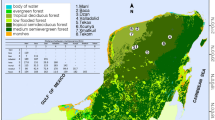Abstract
In the present study we apply a comparative approach, in combination with experimentation, to study behavior of two parasitoid species that attack caterpillar hosts with different feeding strategies (gregarious or solitary). In a semifield setup, consisting of clean cabbage plants and plants infested with one of two host species, the foraging behavior of the specialistCotesia rubecula, on obligate parasitoid of solitarily feedingPieris rapae larvae, was compared to that of the generalistCotesia glomerata, a polyphagous parasitoid of several Pieridae species (mainly the gregariously feedingPieris brassicae).Cotesia glomerata displayed equal propensity to search for and parasitize larvae of both host species. AlthoughC. glomerata exhibited a relatively plastic foraging behavior in that it searched differently under different host distribution conditions, its behavior seems more adapted to search for gregariously feeding hosts. Females exhibited a clear “area-restricted” search pattern and were more successful in finding the gregariously feeding caterpillars.Cotesia rubecula showed a higher propensity to search forP. rapae than forP. brassicae, i.e., females left the foraging setup significantly earlier when their natural hostP. rapae was not present.C. rubecula showed a more fixed foraging behavior, which seems adapted to foraging for solitarily feeding host larvae. In a setup with onlyP. rapae larvae, the foraging strategies of the two parasitoid species were quite similar. In a choice situationC. glomerata did not show a preference for one of the host species, whileCotesia rubecula showed a clear preference for its natural host species. The latter was shown by several behavioral parameters such as the number of first landings, allocation of search time, and percentage parasitization.
Similar content being viewed by others
References
Blaakmeer, A., Geervliet, J. B. F., van Loon, J. J. A., Posthumus, M. A., van Beek, T. A., and de Groot, A. E. (1994). Comparative headspace analysis of cabbage plants damaged by two species ofPieris caterpillars: Consequences for in-flight host location byCotesia parasitoids.Entomol. Exp. Appl. (in press).
Brodeur, J., and Geervliet, J. B. F. (1992). Host species affecting the performance of the larval parasitoidsCotesia glomerata andCotesia rubecula (Hymenoptera: Braconidae). I. Preference for host developmental stage ofPieris (Lepidoptera: Pieridae).Med. Fac. Landbouww. Univ. Gent 57 543–545.
Elkinton, J. S., and Cardé, R. T. (1984). Odor dispersion. In Bell, W. J., and Cardé, R. T. (eds.),Chemical Ecology of Insects, Chapman and Hall, New York, London, pp. 73–91.
Geervliet, J. B. F., and Brodeur, J. (1992). Host species affecting the performance of the larval parasitoidsCotesia glomerata andCotesia rubecula (Hymenoptera: Braconidae). II. Comparative suitability of threePieris species (Lepidoptera: Pieridae).Med. Fac. Landbouww. Univ. Gent 57 547–550.
Geervliet, J. B. F., van Aken, R., Savelkoul, C., ter Smette, S. M., Brodeur, J., Vet, L. E. M., and Dicke, M. (1993). Comparative approach to infochemical use by parasitoids for the case ofCotesia glomerata andCotesia rubecula.Proc. Exp. Appl. Entomol. NEV Amsterdam 4 33–38.
Kaiser, L., and Cardé, R. T. (1991). In-flight orientation to volatiles from the plant-host complex inCotesia rubecula (Hym.: Braconidae): Increased sensitivity through olfactory conditioning.Physiol. Entomol. 17 62–67.
Laing, J. E., and Levin, D. B. (1982). A review of the biology and a bibliography ofApanteles glomeratus (L.) (Hymenoptera: Braconidae).Biocontrol News Inform. 3 7–23.
Nealis, V. G. (1986). Responses to host kairomones and foraging behavior of the insect parasiteCotesia rubecula (Hymenoptera: Braconidae).Can. J. Zool. 64 2393–2398.
Nealis, V. G. (1990). Factors affecting the rate of attack byCotesia rubecula (Hymenoptera: Braconidae).Ecol. Entomol. 15 163–168.
Noldus, L. P. Y. J. (1991). The Observer: A software system for collection and analysis of observational data.Behav. Res. Methods Instrum. Comput. 23 415–429.
Poolman Simons, M. T. T., Suverkropp, B. P., Vet, L. E. M., and de Moed, G. (1992). Comparison of learning in related generalist and specialist eucoilid parasitoids.Entomol. Exp. Appl. 64 117–124.
Sato, Y. (1976). Experimental studies on parasitization byApanteles glomeratus L. (Hymenoptera: Braconidae). I. Parasitization to different species of genusPieris.Appl. Entomol. Zool. 11 165–175.
Sato, Y. (1979). Experimental studies on parasitization byApanteles glomeratus. IV. Factors leading a female to a host.Physiol. Entomol. 4 63–70.
Shenefelt, R. D. (1972). Braconidae 4, Microgasterinae,Apanteles.Hym. Cat. (nov. ed.) 7 429–668.
Steinberg, S., Dicke, M., Vet, L. E. M., and Wanningen, R. (1992). Response of the braconid parasitoidCotesia (=Apanteles)glomerata to volatile infochemicals: Effects of bioassay setup, parasitoid age and experience and barometric flux.Entomol. Exp. Appl. 63 163–175.
van Alphen, J. J. M., and Visser, M. E. (1990). Superparasitism as an adaptive strategy for insect parasitoids.Annu. Rev. Entomol. 35 59–79.
Vet, L. E. M., and van Alphen, J. J. M. (1985). A comparative functional approach to host detection behaviour in parasitic wasps. I. A qualitative study on Eucoilidae and Alysiinae.Oikos 44 478–486.
Vet, L. E. M., and Dicke, M. (1992). Ecology of infochemical use by natural enemies in a tritrophic context.Annu. Rev. Entomol. 37 141–172.
Vet, L. E. M., Sokolowski, M. B., Macdonald, D. E., and Snellen, H. (1993). Responses of a generalist and a specialist parasitoid (Hymenoptera: Eucoilidae) to drosophilid larval kairomones.J. Insect Behav. 6 615–624.
Wäckers, F. L. (1994).Multisensory Foraging by Hymenopterous Parasitoids, Ph.D. thesis, Wageningen Agricultural University, Wageningen.
Author information
Authors and Affiliations
Rights and permissions
About this article
Cite this article
Wiskerke, J.S.C., Vet, L.E.M. Foraging for solitarily and gregariously feeding caterpillars: A comparison of two related parasitoid species (Hymenoptera: Braconidae). J Insect Behav 7, 585–603 (1994). https://doi.org/10.1007/BF01997434
Accepted:
Issue Date:
DOI: https://doi.org/10.1007/BF01997434




